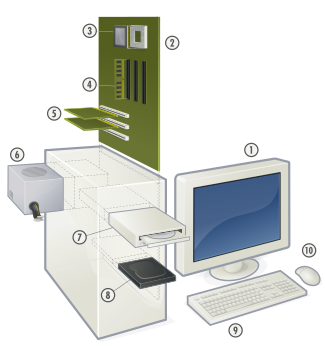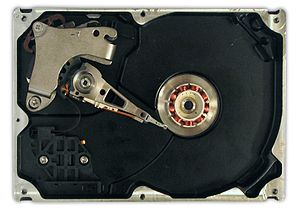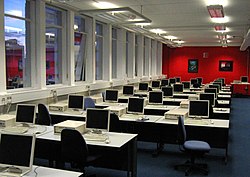Personal computer

A personal computer (PC) is usually a computer whose price, size, and features make it suitable for personal usage, generally in the home. The term was popularized by Apple Computer with the Apple II in the late-1970s and early-1980s, and afterwards by IBM with the IBM PC. Generally, personal computers differ from other types of computers only in terms of their components and function. A workstation or server differ from personal computers primarily by function and grades of components used.
Uses
Personal computers are normally operated by one user at a time to perform such general purpose tasks as word processing, internet browsing, internet faxing, e-mail and other digital messaging, multimedia playback, video game play, computer programming, etc. This is in contrast to most other consumer electronics, which tend to specialize in only a few functions, but tend to outperform general purpose PCs at those tasks. As a result, a video game console (for example) can generally play video games better than an equally-priced computer, but can't do any of a PC's other functions.
The user of a modern personal computer may have significant knowledge of the operating environment and application programs, but is not necessarily interested in or capable of programming for the computer. Therefore, most software written primarily for personal computers tends to be designed with simplicity of use, or " user-friendliness" in mind. However, the software industry continuously provides a wide range of new products for use in personal computers, targeted at both the expert and the non-expert user.
Configuration
Personal computers can be categorized by size and portability:
- Desktop computers
- Laptop or notebooks
- Personal digital assistants (PDAs)
- Portable computers
- Tablet computers
- Wearable computers
Most personal computers are standardized to the point that purchased software is expected to run with little or no customization for the particular computer. Many PCs are also user-upgradable, especially desktop and workstation class computers. Devices such as main memory, mass storage, even the motherboard and central processing unit may be easily replaced by an end user. This upgradeability is, however, not indefinite due to rapid changes in the personal computer industry. A PC that was considered top-of-the-line five or six years prior may be impractical to upgrade due to changes in industry standards. Such a computer usually must be totally replaced once it is no longer suitable for its purpose.
The hardware capabilities of personal computers can sometimes be extended by the addition of expansion cards connected via an expansion bus. Some standard peripheral buses often used for adding expansion cards in personal computers as of 2005 are PCI, AGP (a high-speed PCI bus dedicated to graphics adapters), and PCI Express. Most personal computers as of 2005 have multiple physical PCI expansion slots and a PCI Express (PCIe) bus and one or more expansion slots. Some motherboards contain an AGP bus instead of a PCIe bus, but PCIe has mostly replaced AGP.
Motherboard
The motherboard (or mainboard) is the primary circuit board for a personal microcomputer. Many other components connect directly or indirectly to the motherboard. Motherboards usually contain one or more CPUs, supporting circuitry and ICs for CPU operation, main memory, and facilities for initial setup of the computer immediately after being powered on (often called boot firmware or a BIOS). In many portable and embedded personal computers, the motherboard houses nearly all of the PC's core components. Often a motherboard will also contain one or more peripheral buses and physical connectors for expansion purposes. Sometimes a secondary daughter board is connected with the motherboard to provide further expandability or to satisfy space constraints.
Central processing unit
The central processing unit, or CPU, is the part of the computer that executes software programs, including the operating system. Nearly all PCs contain a type of CPU known as a microprocessor. The microprocessor often plugs into the motherboard using one of many different types of sockets. IBM PC compatible computers use an x86-compatible processor, usually made by Intel, AMD, VIA Technologies or Transmeta. Other computers use Power PC (a RISC architecture), SPARC or other types of CPUs.
Main memory
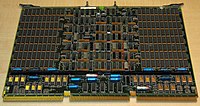
A PC's main memory place (or primary storage) is fast storage space that is directly accessible by the CPU, used to store the currently executing program and immediate data. PCs use semiconductor random access memory such as DRAM or SRAM as their primary storage. Main memory is usually much faster than mass storage devices like hard disks or optical discs, but cannot retain data without power and is more expensive than mass storage. Therefore, it is not generally suitable for long-term or archival data storage.
Mass storage
Mass storage stores programs and data without consuming power. Although semiconductor flash memory has dropped in cost, the prevailing form of mass storage in personal computers is still the electromechanical hard disk.
The disk drives use a sealed head/disk assembly (HDA) which was first introduced by IBM's "Winchester" disk system. The use of a sealed assembly allowed the use of positive air pressure to drive out particles from the surface of the disk, which improves reliability.
If the mass storage controller provides for expandability, a PC may also be upgraded by the addition of extra hard disk or optical drives. For example, DVD-ROMs, CD-ROMs, and various optical disc recorders may all be added by the user to certain PCs. Standard internal storage device interfaces are ATA, Serial ATA, SCSI, and CF+ Type II in 2005.
Graphics - Video card
The graphics card - otherwise called a graphics adapter, video adapter, or video card processes and renders the graphics output from the computer to the VDU or computer monitor and is an essential part of the modern computer. On older and budget models graphics cards tended to be integrated with the motherboard but, more commonly, they are supplied in PCI, AGP, or PCI Express format.
At the introduction of the IBM PC, many personal computers used text-only display adapters and had no graphics capability.
Laptop computers
A laptop computer or simply laptop (also notebook computer or notebook) is a small personal computer designed for mobility. Usually all of the peripherals needed to operate the laptop are built in to a single unit. Most laptops contain batteries to facilitate operation without a readily available electrical outlet.
History
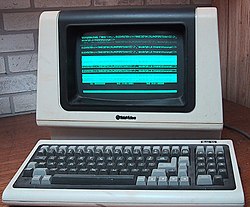
Mainframes and large 'minicomputers'
Before the advent of the microprocessor in the mid 1970s, computers were generally large costly systems owned by universities, institutions and large companies. To make efficient use of computer time, end users often did not directly interact with the machine but instead would prepare tasks for the computer on off-line equipment such as card punches. A number of assignments for the computer would be gathered up and processed in batch mode. After the job had completed, users could collect the results. In some cases it could take hours or days between submitting a job to the computing center and receiving the output.
A more interactive form of computer use developed commercially by the middle 1960's. In a time-sharing system, multiple computer terminals let many people share the use of one mainframe computer processor. This was common in business applications, and in sciences and engineering.
A different model of computer use was foreshadowed by the way in which early, pre-commercial, experimental computers were used, where one user had exclusive use of a processor. Some of the first computers that might be called "personal" were early minicomputers such as the LINC and PDP-8, and later on VAX and larger minicomputers from Data General, Prime, and others. By today's standards they were very large (about the size of a refrigerator) and cost prohibitive (typically tens of thousands of US dollars), and thus were rarely purchased by an individual. However, they were much smaller, less expensive, and generally simpler to operate than many of the mainframe computers of the time. Therefore, they were accessible for individual laboratories and research projects. Minicomputers largely freed these organizations from the batch processing and bureaucracy of a commercial or university computing center.
In addition, minicomputers were relatively interactive and soon had their own operating systems. The minicomputer Xerox Alto (1973) was a landmark step in the development of personal computers, because of its graphical user interface, bit-mapped high resolution screen, large internal and external memory storage, mouse, and special software. [1] The minicomputer era was an intermediary step from mainframes to personal computer usage.
Computers at home
One early use of the term "personal computer" appeared in a November 3, 1962 New York Times article reporting John W. Mauchly's vision of future computing as detailed at a recent meeting of the American Institute of Industrial Engineers. Mauchly stated, "There is no reason to suppose the average boy or girl cannot be master of a personal computer.[2]"
The ancestors of the modern personal computer did not use microprocessors, which explained their size and high cost. After the commercialization of the "computer-on-a-chip", the cost of manufacture of a computer system dropped dramatically. The arithmetic, logic, and control functions that previously occupied several costly circuit boards were now available in integrated form. Concurrently, advances in the development of solid-state memory eliminated the bulky, costly, and power-consuming core storage used in prior generations of computers.
A programmable terminal called the Datapoint 2200 is the earliest known device that bears any significant resemblance to the modern personal computer[3][4]. It was made by CTC (now known as Datapoint) in 1970 and was a complete system in a small case bearing the approximate footprint of an IBM Selectric typewriter. The system's CPU was constructed from a variety of discrete components, although the company had commissioned Intel to develop a single-chip processing unit; there was a falling out between CTC and Intel, and the chip Intel had developed wasn't used. Intel soon released a modified version of that chip as the Intel 8008, the world's first 8-bit microprocessor[5]. The needs and requirements of the Datapoint 2200 therefore determined the nature of the 8008, upon which all successive processors used in IBM-compatible PCs were based. Additionally, the design of the Datapoint 2200's multi-chip CPU and the final design of the Intel 8008 were so similar that the two are largely software-compatible; therefore, the Datapoint 2200, from a practical perspective, can be regarded as if it were indeed powered by an 8008, which makes it a strong candidate for the title of "first microcomputer" as well.
Development of the single-chip microprocessor was an enormous catalyst to the popularization of cheap, easy to use, and truly personal computers. The Altair 8800, introduced in a Popular Electronics magazine article in 1975, at the time set a new low price point for a computer, bringing computer ownership to an admittedly select market in the 1970s. It was arguably this computer that spawned the development of both Apple Computer as well as Microsoft, spawning the Altair BASIC programming language interpreter, Microsoft's first product. The second generation of microcomputers — those that appeared in the late 1970s, sparked by the success of the Steve Wozniak-designed Apple release, the Apple II — were usually known as home computers. These were less capable and in some ways less versatile than large business computers of the day. They were generally used by computer enthusiasts for learning to program, running simple office/productivity applications, electronics interfacing, and general hobbyist pursuits. By the late 1990's, the "home computer" was becoming a less common label in favor of "personal computer." The graphics and sound capacities of "home" systems were matched by those intended for "business" purposes, with a general decrease in costs. The two market segments fused. These computers were pre-assembled, often pre-configured with bundled software, and required little technical knowledge to operate.
Back to business
It was the launch of the VisiCalc spreadsheet, initially for the Apple II (and later for the Atari 8-bit family, Commodore PET, and IBM PC) that turned the microcomputer into a business tool. This was followed by the August 12 1981 release of the IBM PC which would revolutionize the computer market. The Lotus 1-2-3, a combined spreadsheet (inspired by VisiCalc), presentation graphics, and simple database application, would become the PC's own killer app. Good word processor programs would also appear for many home computers, in particular the introduction of Microsoft Word for the Apple Macintosh in 1985 (While earlier versions of Word had been created for the PC, it became popular initially through the Macintosh.).
In the January 3 1983 issue of Time magazine, the personal computer was named the "Person of the Year" for 1982.
Today
During the 1990s, the power of personal computers increased radically, blurring the formerly sharp distinction between personal computers and multi-user computers, such as mainframes. Today higher-end computers often distinguish themselves from personal computers by greater reliability or greater ability to multitask, rather than by brute CPU ability.
In today's common usage, personal computer and PC usually indicate an IBM PC compatible. Due to this association, some manufacturers of personal computers that are not IBM PCs avoid explicitly using the terms to describe their products. Mostly, the term PC is used to describe personal computers that use Microsoft Windows operating systems.
Non IBM-compatible personal computers
Though many personal computers are compatible with IBM PCs using either Microsoft Windows or Unix-likes such as Linux, a number of other personal computer types are also popular. Note that in many regions, in popular usage the term "PC" (though simply short for "personal computer") has become synonymous with "IBM PC–compatible."
A leading alternative to the IBM-compatible PC is the Macintosh (thus the commonly heard comparative, "PC vs. Mac"). The Macintosh originally used the Motorola 68000 series, then shifted to the IBM and Motorola PowerPC processors. This makes the term “IBM-compatible” particularly ironic, since the Macintosh was powered by an IBM chip, though neither IBM PCs nor so-called “IBM-compatibles” were.
In January, 2006, Apple shifted its architecture to the same Intel processor family found in many so-called “IBM-compatibles.”
List of other non IBM compatible PC's
Pre-PC systems This is a list of non IBM PC compatible business personal computers (PC), and Personal Workstation (PW) computers, that came on the market before the IBM-PC.
- Apple III designed as a business system by Apple Inc.
- Astrocom 760 by Astrocom Corporation
- CBM series machines by Commodore International
- CompuColor 8001 by Intecolor
- DEC Professional (computer) from Digital Equipment Corporation
- DPS-1 by Intersystems
- NorthStar Horizon by North Star Computers
- HP-85A From Hewlett-Packard
- MSI computer systems from Midwest Scientific Instruments
- M20 from Olivetti
- Noval 760 by Noval/Gremlin
- PC-9800 system from NEC
- RCC REX by Realistic Controls Corporation
- S-100 bus systems, build from components made by various companies
- C4P and C8P systems made by Ohio Scientific
- SBC/9 by Percom
- SBS-8000 by Small Business systems
- Sol-20 by Processor Technology
- Sphere computer by Sphere inc.
- Superbrain by intertec Data Systems
- SWTPC systems
- TRS-80 model II by Tandy Corporation
- Victor 9000 by Sirius Systems Technology
- Z-89 by Zenith/Heathkit
Post-PC systems This is a list of non IBM PC compatible business personal computers (PC), and Personal Workstation (PW) computers, that came on the market after the IBM-PC.
- Acorn Archimedes & RiscPC
- ACT Apricot by ACT (Runs MS-DOS but is NOT IBM PC compatible.) [6]
- Apple Lisa by Apple Inc.
- Amiga (previously produced by Commodore, now under license from Amiga Inc.)
- Amstrad PCW series (Personal Computer Word processor) from Amstrad
- Atari ST
- BeOS BeBox
- C-10 by Cromemco
- Compustar II VPU Model 20 by Intertec
- Corvus Concept by Corvus Systems
- HP 150 by Hewlett-Packard. (Runs MS-DOS but is NOT IBM PC compatible.) [6]
- Kaypro 10 by Kaypro
- Knowledge Worker by A.B.Dick Comp.
- Micro 16s by Fujitsu
- Micro Decision by Morrow Designs
- NeXT workstations by Next Software
- PC-8800 by NEC
- Pegasos by Genesi
- QX-10 by Epson
- Rainbow 100 from Digital Equipment Corporation (Runs MS-DOS but is NOT IBM PC compatible.) [6]
- RoadRunner from MicroOffice
- SGI workstations like the SGI Indigo and SGI Onyx
- Sun SPARCstation
- TI Professional Computer by Texas Instruments
- Tulip System-1 by Tulip Computers company. (Runs MS-DOS but is NOT IBM PC compatible.) [6]
The term "personal computer" is often avoided by advocates of the above computer systems, because of the association with the "PC" in "IBM PC".
IBM-compatible is a historical term since IBM no longer manufactures personal computers. It is still a short-hand way of designating, especially during the period 1981–1997, a computer generally similar to the original IBM PC, XT and AT. Pragmatically, the operational definition of "compatible personal computer" is now "capable of running the current edition of Microsoft Windows".
See also
- Apple Computer, Apple II, Apple Lisa, and Apple Macintosh
- Computer
- Desktop replacement computer
- Gaming PC
- History of computing hardware (1960s-present)
- Home computer
- Laptop
- Silent PC
- HTPC
- Microcomputer
- Minicomputer
- Mainframe computer
- Osborne 1
- Supercomputer
- Xerox Star
Notes
- ↑ Rheingold, H. (2000). Tools for thought: the history and future of mind-expanding technology (New ed.). Cambridge, MA etc.: The MIT Press.
- ↑ "Pocket Computer May Replace Shopping List", New York Times, 1962-11-03.
- ↑ http://www.americanheritage.com/articles/magazine/it/1994/2/1994_2_64.shtml
- ↑ http://www.old-computers.com/museum/computer.asp?st=1&c=596
- ↑ A History of Modern Computing, (MIT Press), pp. 220–21
- ↑ 6.0 6.1 6.2 6.3 This means that MS-DOS is ported to this machine, and is using BIOS calls to interface with the hardware, but the architecture of the hardware is completely different. So IBM-PC software that directly writes to (for example) the video screen (which almost all software did) won't work. The differences with the IBM-PC architecture could be huge. Especially the memory mapping and the video display hardware, but even simple things like the way the keyboard was interfaced to the system could be completely different
External links
- Old Computers Museum (all computer types)
- Rune's PC Museum
- Custom PC Guide A regularly updated PC/HTPC buyer's guide.
- The PC Guide contains detailed historical and technical information.
- Howstuffworks' article on "How PCs Work"
- Wikicity for PC enthuiasm
- BlinkenLights Archaeological Insititute - Personal Computer Milestones What was the first personal computer?
- "Total share: 30 years of personal computer market share figures" — From Ars Technica
